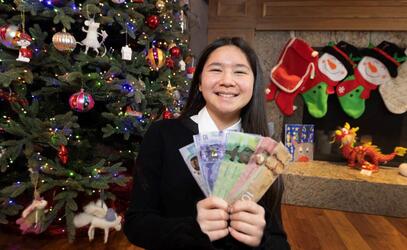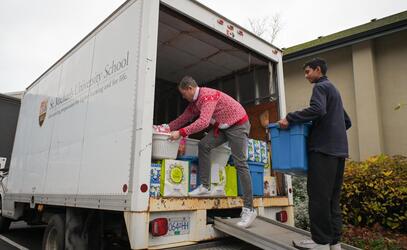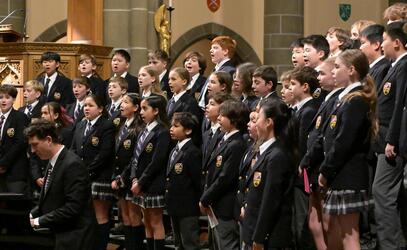How might we redesign our Middle School to better support the learning needs of our students and SMUS’s sustainability goals?
This is the real-world challenge that Head of School Mr. Mark Turner posed to our Grade 6 students earlier this year. The Sustainable Middle School Redesign project is a cross-curricular project that ties together learning in humanities, math, science and design. Students work in groups to research sustainable solutions and create a new design for our Middle School that includes more facilities, while also being mindful of water use, waste, food production, energy consumption and transportation.
During Term 3, Grade 6 classes went on field trips and enjoyed talks from guest speakers, all of which helped inform their learning and the detailed campus maps they created.
Last week, students presented their projects to classmates, teachers and parents. The presentations were impressive and comprehensive, and it was evident that students were committed to making their projects as great as possible, optimistic that some of the changes they suggest can come into effect.
Below, some Grade 6 students reflect on their learning:
by Willow T.
During the Sustainable Middle School Redesign project there were lots of ups and downs, great ideas and many hours of work, but altogether I think that it was definitely one of the most fun projects of my entire Grade 6 year. A huge highlight for me was coming up with all of the ideas and improvements that we would then add to our draft map. I also very much enjoyed creating and designing the map.
Through this entire process of researching and creating, we had a few guest speakers come in and talk to us about what you should consider while designing a sustainable school. They talked to us about food production to transportation and the most healthy ways to get to school. One of my favourite presenters was Sarah Webb, Manager of Sustainable Transportation Planning and Development from the City of Victoria. She showed us some really cool bike storage ideas from Japan like underground bike parking and car vending machines. She also talked about how carpooling and taking the buses can make a huge impact on the environment. I think that this talk will stick with me because Sarah Webb was so enthusiastic about her presentation.
After we had gathered all of our information, we had to think of ideas and collaborate to make the final map. I think that this was the most difficult (and the best) part of the process because it really worked our brains to see that not all of our ideas could be used. I think that this would be a great project for the future students because I think and hope that they will enjoy this project as much as I have.
by J. Elijah H.
I liked that most of the groups added a different source of energy to the school; most groups used solar, wind or geothermal. Another thing I liked about some of the redesign projects was that a lot of groups added rooftop gardens, wall gardens or just simply just a bigger garden for us to grow our own food.
I think that most people thought that the experience of seeing and meeting people who helped us with our project was pretty cool. We liked that we didn’t just have to research on our computers but could listen to people as well. We learned what sustainability is and especially how to be more sustainable. I think that the lessons on sustainability will stick with us throughout the course of our lives.
by Deristhi G.
“Less Meat=Less Heat” refers to the fact that the worldwide production of livestock generates more greenhouse gases, such as methane, than the entire transportation sector. Incorporating Meatless Mondays into the school calendar is a practical, climate-smart solution that promotes sustainability by reducing meat consumption and improving the health of the planet.
Placing donation bins on each floor of the Middle School will allow students to donate clothing and gently used items they no longer want or need. In addition to diverting waste from the Hartland Landfill, people in need will benefit from the donations. Donation bins will encourage students to recycle, re-purpose and re-use products. By adopting these sustainable actions, students will reduce their environmental impact, at school and beyond.
The biggest challenge during the project was creating the map on Inkscape in a short amount of time. We overcame this by breaking down the project into smaller tasks, which we shared among our group members. I learned that I could achieve an overwhelming goal by dividing it into less intimidating steps that feel easier to complete.
Every aspect of this project was unique, in that, each experience opened my eyes to different ways in which humans are impacting on the planet. During the planning stages, I came across a quote from an activist, Robert Swan, that said, "The greatest threat to our planet is the belief that someone else will save it." As such, the thing I liked most was learning about eco-friendly actions that I can take to promote sustainability. Going forward, I am making (and will continue to make) a conscious effort to reduce and divert waste by recycling, re-purposing and re-using products.
by Harris R.
One of the structures that really helped shape the look of my group's Middle School redesign was the dome that we planned for the back of the school. The reason I think this was a key aspect of our school redesign was the fact that almost everything revolved around the dome, and if we hadn’t put the dome in, our school would have looked drastically different. Another idea that was crucial in our redesign was the rainwater harvester. The reason that we included this was because of how much rainwater would go to waste and seep into the ocean without it. We researched the topic and found a piece of equipment – the harvester – that takes the water, cleans it and turns it into drinkable water.
Throughout the course of the project we had a few difficulties to overcome. The biggest of these was figuring out how to acknowledge all group members’ goals and create a solution that was mutually beneficial. We struggled with this at the start, but as we progressed we came to see each other's point of view, making it easier to reach a compromise.
I think the best part of this project was when we put all of our ideas together and combined them in the map on Inkscape. For the first time, I could really visualize what our new school was shaping up to be. I also enjoyed the process of making the maps in Inkscape because I found the software really fascinating. Another thing I liked was the field trips and talking to the experts who focus on sustainability for their profession. I thought this was interesting because a lot of the experts exposed me to new ideas that I had never thought of before.


